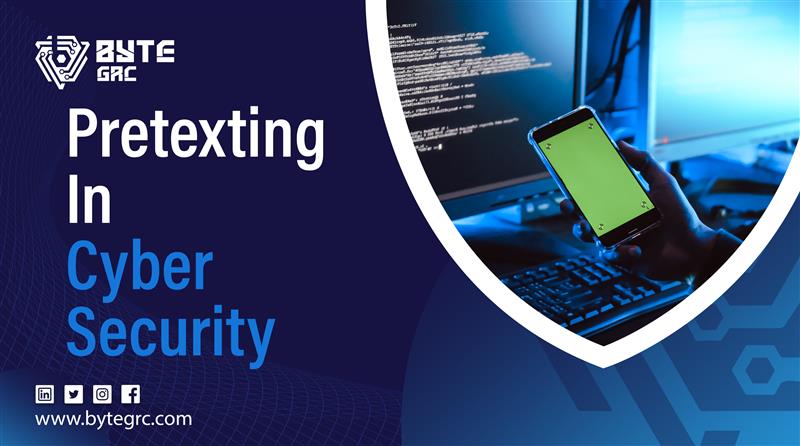|
Getting your Trinity Audio player ready...
|

Table of Contents
What Is Pretexting In Cyber Security? Attacks, Examples & Technique
Have you ever received a suspicious phone call from someone claiming to be your bank or IT department? That might’ve been pretexting—a sneaky trick that cybercriminals use to get your trust and steal your information.
Pretexting in cyber security is a type of social engineering attack where the attacker creates a fake story (or “pretext”) to trick people into giving up private information. It could be a phone call, an email, or even a face-to-face chat. The attacker plays a role—like a company executive or tech support—and uses this lie to make the target feel safe enough to share sensitive data.
In this blog, we’ll explain what pretexting is, how it works, real-life cases, the techniques used, and—most importantly—how to protect yourself and your business from these clever cyber tricks.
What is Pretexting in Cyber Security
Pretexting is when an attacker pretends to be someone else to fool the victim. The goal is to build trust using a believable story. For example, they might say they’re from your company’s IT department and need your password to “fix an issue.”
What makes pretexting so dangerous is the psychological manipulation behind it. Criminals study how people think and react. They often rely on human communication, not hacking tools, to get what they want. By using social influence, urgency, or fear, they push people to act without questioning the request.
Pretexting is part of the wider world of cybercrime, where deception is often more powerful than software.
How Pretexting in Cyber Security Differs from Other Attacks
While pretexting is a form of social engineering (security), it’s different from other scams:
- Phishing: Sends fake emails or texts to trick users into clicking harmful links.
- Voice phishing (vishing): Uses phone calls to deceive targets.
- Baiting: Lures people with offers (like free USB drives) to install malware.
- Tailgating: Physically follows someone into a secure area without permission.
Pretexting is often more sophisticated. It takes planning, research, and clever acting. Instead of just sending mass emails, attackers study their victims to tailor the lie. This makes the scam harder to detect.
Common Goals of Pretexting Attacks
Why do attackers use pretexting? Here are the usual goals:
- Stealing sensitive data: This includes passwords, bank details, and personal data.
- Gaining system access: To break into networks, emails, or cloud platforms.
- Corporate espionage: Some attacks aim to steal company secrets.
- Financial fraud: Trick employees into making payments or transfers.
These crimes don’t just affect individuals. Businesses, governments, and service industries are often prime targets.
How Pretexting In Cyber Security Works: The Attack Lifecycle
Let’s break down the steps attackers follow:
Researching the Target
Attackers gather details from:
- Social media platforms like LinkedIn
- Company websites and press releases
- Public records and digital media
This helps them build a believable story and find “trust points.”
Crafting a Believable Scenario
They create a fake identity, like:
- An IT technician
- A senior executive
- A vendor or supplier
They use emotions—fear, urgency, or curiosity—to pressure the victim. This emotional manipulation is a core part of deception in cyberspace.
Executing the Attack
The attacker may reach out via:
- Phone call (voice phishing)
- Email or text messaging
- In-person meetings
They play their role smoothly and confidently, using credible details to build trust.
Extracting Information or Access
Once trust is gained, they ask for:
- Passwords or authentication codes
- Financial information
- Access to systems or files
They might use this data to:
- Steal money
- Launch more attacks
- Sell the info on the dark web
Real-World Examples of Pretexting Attacks
Here are some real-world examples of pretexting attacks:
The 2016 Ubiquiti Networks Scam ($46.7M Loss)
Attackers pretended to be top executives and emailed employees with fake payment requests. Employees trusted the messages and wired the money—falling victim to one of the biggest internet fraud cases.
The Twitter Bitcoin Scam – 2020
Hackers used a mix of pretexting and phishing to access Twitter’s admin tools. They took over high-profile accounts (Elon Musk, Obama) and posted scam messages asking for Bitcoin.
Hewlett-Packard Scandal – 2006
In this case of corporate crime, HP investigators used pretexting to get phone records by pretending to be board members. This led to a huge scandal and changes in data laws.

Common Pretexting Techniques Used by Attackers
The following are the common pretexting techniques used by cyber attackers:
Impersonation Attacks
Criminals pose as:
- CEOs or managers
- Government agents
- IT support teams
They exploit identity management systems and telephony tricks to seem legit.
Fake Emergency Scenarios
Attackers create panic, saying:
- “Your account was hacked—give me your login now!”
- “You’ll lose access if you don’t act fast!”
This urgency pushes people to skip security protocols.
Authority Exploitation
Using fake credentials or titles, they create a sense of power and control. Victims feel obligated to respond.
Tailored Social Engineering
The attacker might mention:
- A recent birthday
- A new project at work
- Company events
These details increase their credibility.
How to Detect and Prevent Pretexting Attacks
Let’s explore how to detect and prevent from pretexting attacks:
Red Flags of a Pretexting Attempt
Watch out for:
- Strange or urgent requests for sensitive info
- Emails or calls with slightly wrong details (misspelled names, wrong job titles)
- Unusual sender domains or spoofed email addresses
Best Practices for Individuals
- Verify identities before sharing any information
- Avoid oversharing on social media
- Use multi-factor authentication (MFA) for all accounts
Best Practices for Organizations
- Train staff on cybersecurity awareness and social engineering threats
- Require double-checks for requests involving money or access
- Perform regular security audits
Technical Defenses Against Pretexting
- Use email filters with DMARC and SPF settings to detect fakes
- Install endpoint protection to stop malware
- Set up strong access control rules
Legal and Ethical Implications of Pretexting in Cyber Security
Laws
In the U.S., the Telephone Records and Privacy Protection Act makes pretexting illegal. Other computer laws and privacy laws vary by region but often include heavy fines and jail time.
Ethics
Some cybersecurity pros use ethical pretexting during penetration testing—but it must follow strict rules. Crossing the line into tricking people without consent is considered misconduct.
Consequences
For attackers, punishment may include:
- Criminal charges
- Fines
- Imprisonment
For businesses, failing to stop these attacks can damage reputation, cause data breaches, and result in legal trouble.
Conclusion
Pretexting in Cyber Security is a growing threat in today’s digital world. It relies on human behavior, not just computer flaws. From fake phone calls to clever emails, attackers use psychological tricks to gain trust and steal valuable information.
Knowing how these scams work—and teaching your team to spot them—is key to strong information governance. At Byte GRC, we help businesses build smarter defenses with practical tools and training. Don’t let deception win. Protect your data and boost your security posture today.
FAQs
1: What is the difference between pretexting and phishing?
Phishing targets many users with fake emails, while pretexting uses a detailed, personalized lie to trick a specific person.
2: Can pretexting happen over the phone?
Yes, it’s often done through voice phishing or fake calls from “support teams.”
3: What kind of data do attackers want in pretexting?
Passwords, financial info, business secrets, or access to systems.
4: How can companies protect against pretexting?
Employee training, MFA, identity checks, and strict verification processes.
5: Are there laws against pretexting?
Yes. The U.S. and many countries have computer laws and data protection rules.
6: Is pretexting part of cyberwarfare?
It can be. Some state-sponsored actors use pretexting in digital espionage.
7: What should I do if I suspect a pretexting attack?
Report it to your IT or security team right away. Don’t respond or share any information.

